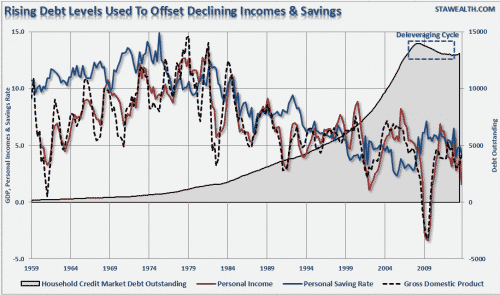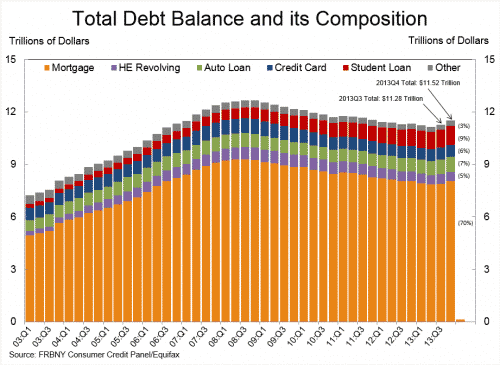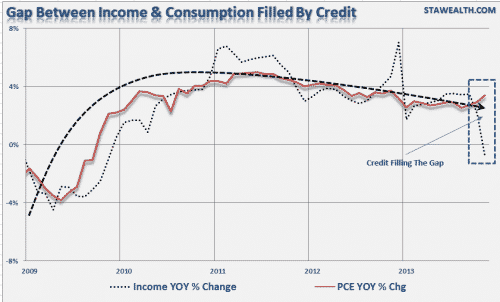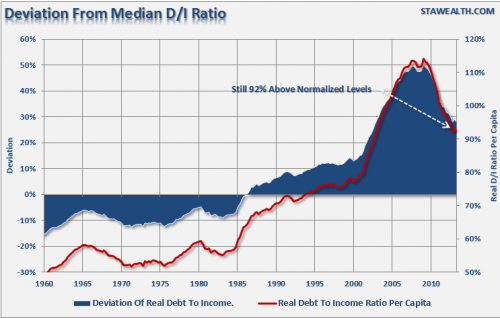Will consumer credit drive the next economic boom?
Just recently the Federal Reserve Bank of New York released its quarterly survey of household debt which showed an increase of $24.1 billion in the fourth quarter of 2013. My friend Cullen Roche commented on this increase stating:
“This was the first year over year increase in debt since 2008. It’s a pretty momentous occasion in my view as it changes the dynamics of the economy from one in which we were de-leveraging to one which is now officially re-leveraging without government aid.”
The importance of this comment is that it was the “leveraging” up of the household balance sheet that supported economic growth, beginning in the 1980’s, as shown in the chart below.
As the deregulation of the banking industry occurred, it led to a consumer credit driven society. The age of “easy credit terms” and “no money down” led to a consumption boom that offset a decline in actual economic productivity, incomes and savings. Of course, the basic lesson of economics is that it is savings that ultimately leads to productive investment, production and economic growth. Unfortunately, we have precious few of those key ingredients available.
However, there are two potential issues with the current re-leveraging cycle. First, the increase in the latest report, outside of real estate related mortgages as shown in the chart below, was primarily driven by increases in student and auto loan debt.
The two primary areas of increase in debt are also those with the highest default rates as they are primarily “sub-prime” in nature. However, with low savings rates and rising costs of living, it is not surprising that debt is used to offset the differential. The chart below shows the gap between incomes and spending.
What is important to remember is that a BIG chunk of the “deleveraging” process that occurred was not from consumers becoming more conscious about the financial stability. Primarily that process occurred through “force” as the financial crisis led to a wave of foreclosures, bankruptcies, debt forgiveness and restructuring. In the past, a “bankruptcy” meant no credit for at least seven years. Today, as long as you can blame the financial crisis for your personal insolvency, credit can be quickly restored. There is already emerging evidence that subprime borrowers are once again gaining traction in the credit markets, bonds are being issued on very risky collateral such as “rental income streams” and mortgages are being issued with very low, or no, down payments. Since it all worked out so well before, it makes perfect sense to do it again.
The good news is that median debt to income ratios per capita has declined from all-time peaks. However, as stated above this was primarily by “force” rather than choice. However, for those hoping that a resurgence in personal debt will lead to the next great economic boom – there is likely to be some disappointment. With the deviation from the long-term median debt to income ratio still extremely elevated, it is likely there is little room to recreate the consumption boom of the 90’s.
Furthermore, it is important to remember that the demographic shift will also play a key role as the massive “baby boomer” generation moves from “upsizing” to “downsizing.” The first chart above really tells the story of how debt masked a weakening economy over the last 30 years. Of course, this is also why we stand at the crossroad between economic growth and recession. Much like a patient on “life support,” economic growth remains tied to ongoing interventions of monetary policy.
The mirage of prosperity created by massive levels of debt has begun to show it foundational cracks. Without increased levels of personal savings, production and investment there is little ability to achieve stronger economic growth. While we can certainly “hope” for something different, there are some basic laws which are insurmountable. The physics of debt is one of them.




Comments are closed.